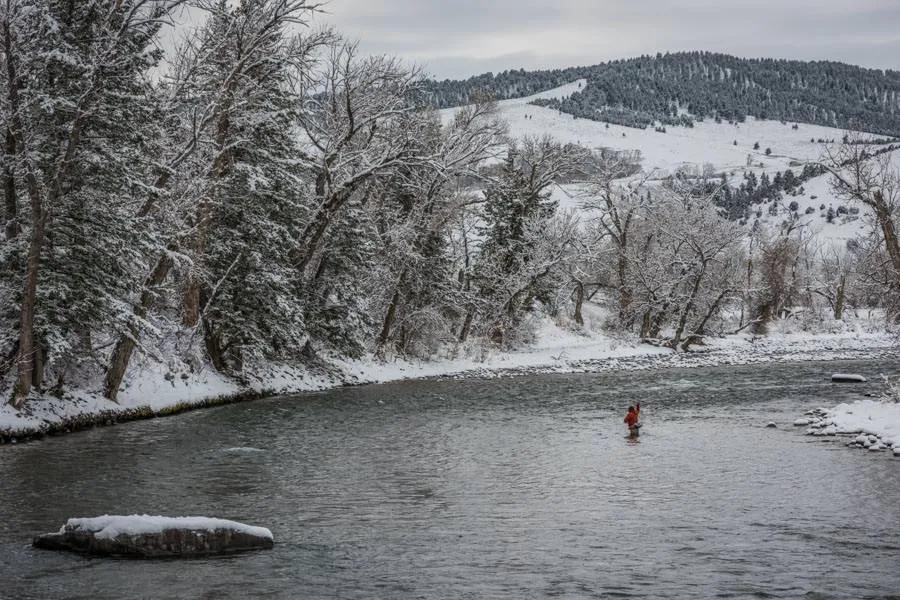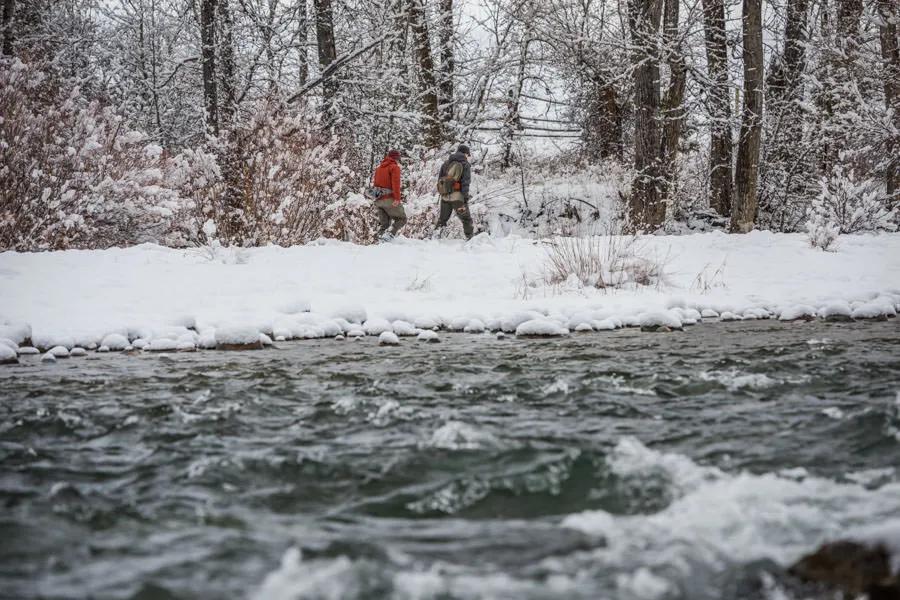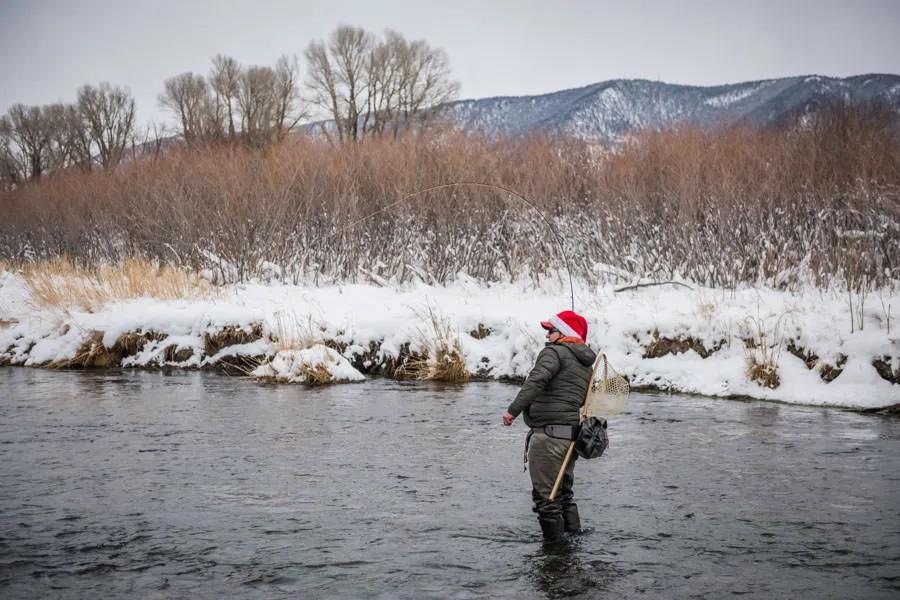
Cut to the scene: snowcapped mountains are backdrop by a Montana river and snow falls softly on the water's surface, disappearing as they melt. Your cast lays out perfectly placing the fly into a fishy looking seam and the hope a fish will take grows. Winter fly fishing in Montana is a unique experience best summed up by solitude on the river, using a fresh set of angling skills, and Montana fly fishing that looks a little different than the regularly advertised programming. The Bozeman and Big Sky region of Montana is home to a variety of consistently good fly fishing rivers and streams. Fly fishing in summer in Montana is defined by long, sunny days and local communities often abuzz with travelers and tourists. But, winter on our rivers is often a season of reflection, enjoying a second cup of coffee before heading out, and returning home well before the dinner hour. If you are a Bozeman local or looking to expand your angling horizons, here are some winter fly fishing options in the Bozeman and Big Sky, Montana region.

The Gallatin River
The Gallatin River flows from Yellowstone National Park to meet the Madison and Jefferson Rivers west of Bozeman to make the famous Missouri River. Winter is a great time to be on the Gallatin River, which can be quite busy during the summer. The easy access and spectacular scenery from A River Runs Through It fame make this a worthy destination. It’s close proximity to Bozeman and Big Sky Resort make it a prime target. While the entire river can fish well, the area around Big Sky is the most popular. Here, many springs enter the river, raising the water temperature substantially. During extreme cold snaps, the river can freeze solid except for the areas where springs enter into the river. If a warm front--temps above 30 degrees or so--sustains, the entire Gallatin Canyon can fish well. The water above Big Sky and in the valley south and west of Bozeman can have significant ice jams during prolonged cold weather, so unless you know it well, fishing the Gallatin near Big Sky is the best option. Several years ago one of these ice jams above Big Sky abruptly broke, sending a tsunami of water downstream (search “Gallatin Tsunami” on Youtube). While this is certainly a freak occurrence, it is a good reminder to keep your eyes peeled while on the water when fishing the Gallatin during a warm spell immediately after a prolonged cold snap.
For flies and tactics for fishing the Gallatin River in winter, keep things simple. Basic stonefly patterns and small, attractor nymphs are all you really need. The Gallatin is fished best with subsurface nymphs in winter, so be sure to have some of the following patterns in your box: Pat's Rubberlegs in size 12 and 14, Zebra Midges in black or red in size 16 to 20, Beadhead Pheasant Tails, Prince Nymphs, Lightning Bugs, and Little Green Machines in size 14 to 18. It is a good idea to carry a few midge dry fly patterns just in case. A Buzzball or Griffith's Gnat in size 18 to 22 should suffice. Use 9 foot or 7.5 foot leaders that are tapered down 4X and 5X. Lighter tippets are often important to get a quality drift. If you are fishing subsurface use fluorocarbon and if fishing small dry flies on the surface, a supple monofilament is important. Be sure to read some of our recent blog articles for leader selection and 5 Top Tips for Winter Fishing and Tips That Go Beyond Just Dressing Warm.

The Madison River
The Madison River in winter is best broken down into the two main sections, the Upper Madison and the Lower Madison. The Upper Madison is the river between Quake Lake and Ennis. Winter fishing on the Upper Madison is best in the section of the first several miles downstream of Quake Lake. On the Lower Madison, most of the winter fishing occurs at the lower end of Beartrap Canyon because access is easy with roads that travel along each side of the river. Some intrepid anglers will hike into Beartrap Canyon. Beartrap Canyon is a wilderness area that can be accessed from its upper end just below Ennis Dam or its lower end from a trailhead from the Warm Spring’s boat ramp. Reading the water on the Lower Madison can be difficult to the uninitiated because it is a very broad, flat, uniform river. The river contains many weedbeds and sandbars, and you are looking for the “buckets” of slower, deeper water created in the river. There is also some more obvious structure in the form of large boulders and islands. This section of river can be a bit frustrating at first, but becomes pretty easy to read if you put in some time.
The Upper Madison in winter is best fished with small, beadhead nymphs, and midges subsurface using a strike indicator or using tight-line or Euro-nymph tactics. Best patterns for the Upper Madison in winter are Pat's Rubber Legs in size 12 and 14, various beadhead mayfly nymphs in sizes 16 to 20, Zebra midges in black or purple in sizes 18 to 22. The Lower Madison contains an abundant population of crayfish, so a crayfish imitation makes a good lead fly. As usual, San Juan Worms produce well and are another good choice. For a dropper nymph, use something with a little flash to it, so carry various small, flashy nymphs such as Lightning Bugs and Copper John’s in #16 and #18. The Lower Madison can have good midge hatches during the winter, but the wind can often make it tough to fish dry flies. Look for rising fish in protected waters along the willows or in back eddies. It is a good idea to carry a few midge dry fly patterns just in case. A Buzzball or Griffith's Gnat in size 18 to 22 should suffice. Use 9 foot or 7.5 foot leaders that are tapered down 4X and 5X. The lighter tippets are important to get a quality drift. If you are fishing subsurface use fluorocarbon and if fishing small dry flies on the surface, a supple monofilament is important. Be sure to read some of recent blog articles for leader selection and 5 Top Tips for Winter Fishing and Tips That Go Beyond Just Dressing Warm.

The Paradise Valley Spring Creeks near Livingston
Within a half hour from Bozeman flow some of the world's most renowned spring creek fisheries. DePuy's and Armstrong's Spring Creeks originate from naturally occurring springs and flow at a constant temperature of 52 degrees F year-round. Because the water temperature and flow volume remains unchanged, the winter fishing on these small creeks is some of the most reliable in the area. Because the Paradise Valley Spring Creeks originate on private ranches, anglers wanting to fish the creeks need to pay the landowners a trespass/rod fee to fish. The winter rates on the creeks are the lowest of the year, $40 per day through mid-April. It is also very easy to get a reservation at the last minute, while reservations for prime summer dates need to be made more than 6 months to a year in advance.
If you are looking for dry fishing opportunities in winter near Bozeman or Big Sky, the spring creeks are going to have the best potential. Hatches of midges are a daily occurrence and sporadic hatches of Blue-Winged Olives can occur as well. Because dry fly fishing is always a possibility on the spring creeks, be sure to have some midge dry fly patterns like a Griffith's Gnat, Buzzball, or Palomino midge in sizes 18 to 22. For nymphs, midge larvae and pupa are important, but small pheasant tail and mayfly nymphs are also important to have on the spring creeks in winter. Effective nymphs include Sawyer Pheasant tails in sizes 18 to 22, Little Green Machines and Zebra midges in sizes 18 to 22. Small scuds and sowbugs like Ray Charles or Carpet Bugs in gray or light pink in size 18 to 22 are also popular.
Reading the water on the spring creeks is different than on a freestone as well. Since the water temperature is warmer on the creeks compared to other area waters, the fish are not packed into a few deep holes. They can be found throughout the creeks, including more moderate speed runs and riffles. A good strategy on the creeks is to choose the type of water to fish based on the technique you'd like to use---dry fly fishing, sight-nymphing, or deep nymphing below an indicator. When nymphing, target runs that are 3 to 5 feet deep and deep holes and runs that are slow and over 5 feet deep. When looking for risers and fishing dries, target gentle riffles, glides, and flats. Always move slow when fishing on the spring creeks and keep an eye out for fish holding or feeding.
Leader and tippet selection is important when fishing the spring creeks. Use 12 foot or 15 foot leaders that are tapered down 5X and 6X. The lighter tippets are important to get a quality drift. If you are fishing subsurface use fluorocarbon and if fishing small dry flies on the surface, a supple monofilament is important. Be sure to read some of recent blog articles for leader selection and 5 Top Tips for Winter Fishing and Tips That Go Beyond Just Dressing Warm.

Fly fishing in winter provides adventurous anglers unique opportunities that do not exist when the weather is warm and the living is easy. For those willing to brave the cold, the rewards can be a mix of extrinsic and intrinsic--extrinsic because plenty of fish can be caught and intrinsic because the wintry weather keeps the causal anglers on the couch. Being brave and brash to fish in snow, sleet, and freezing-like conditions can be a matter of having the will, and proper gear, to endure, but catching fish in winter requires some specialized skills that go beyond just being dressed appropriately and having a good attitude.
